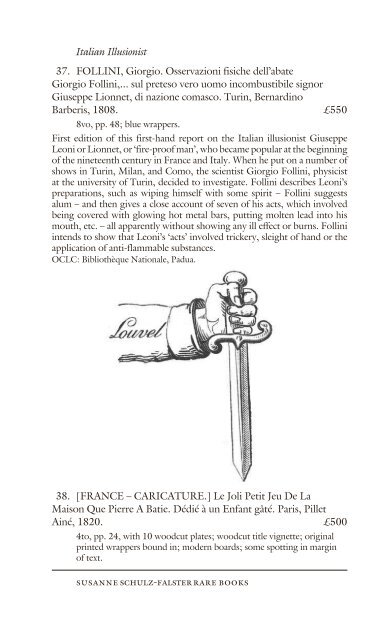Susanne Schulz-Falster Catalogue Eighteen - International League ...
Susanne Schulz-Falster Catalogue Eighteen - International League ...
Susanne Schulz-Falster Catalogue Eighteen - International League ...
You also want an ePaper? Increase the reach of your titles
YUMPU automatically turns print PDFs into web optimized ePapers that Google loves.
Italian Illusionist<br />
37. FOLLINI, Giorgio. Osservazioni fisiche dell’abate<br />
Giorgio Follini,... sul preteso vero uomo incombustibile signor<br />
Giuseppe Lionnet, di nazione comasco. Turin, Bernardino<br />
Barberis, 1808. £550<br />
8vo, pp. 48; blue wrappers.<br />
First edition of this first-hand report on the Italian illusionist Giuseppe<br />
Leoni or Lionnet, or ‘fire-proof man’, who became popular at the beginning<br />
of the nineteenth century in France and Italy. When he put on a number of<br />
shows in Turin, Milan, and Como, the scientist Giorgio Follini, physicist<br />
at the university of Turin, decided to investigate. Follini describes Leoni’s<br />
preparations, such as wiping himself with some spirit – Follini suggests<br />
alum – and then gives a close account of seven of his acts, which involved<br />
being covered with glowing hot metal bars, putting molten lead into his<br />
mouth, etc. – all apparently without showing any ill effect or burns. Follini<br />
intends to show that Leoni’s ‘acts’ involved trickery, sleight of hand or the<br />
application of anti-flammable substances.<br />
OCLC: Bibliothèque Nationale, Padua.<br />
38. [FRANCE – CARICATURE.] Le Joli Petit Jeu De La<br />
Maison Que Pierre A Batie. Dédié à un Enfant gâté. Paris, Pillet<br />
Ainé, 1820. £500<br />
4to, pp. 24, with 10 woodcut plates; woodcut title vignette; original<br />
printed wrappers bound in; modern boards; some spotting in margin<br />
of text.<br />
susanne schulz-falster rare books catalogue eighteen<br />
First edition of this illustrated pro-Bourbon satire disguised as a children’s<br />
book and illustrated with ten woodcut plates. The text is inspired by the<br />
popular English nursery rhyme, ‘The House that Jack built’. The pamphlet,<br />
here with the original printed wrappers present, pillories the impact Louvel’s<br />
assassination of the Duc de Berry had on French political life. The ‘Maison que<br />
Pierre a bâtie’ is solidly built, divided into three chambers, the constitutional<br />
monarchy flanked on either side by the Chamber of Peers and the Chamber<br />
of Deputies, and resting on the foundation of the Catholic Church. A band<br />
of revolutionaries arrive threatening the structure, supported by politicians,<br />
journalists and rabble-rousers, all depicted on the further illustrations. This<br />
leads up to the dramatic plate showing an upraised arm labelled ‘Louvel’<br />
wielding a dagger, in fact a dagger sharpened ‘by the grindstone of liberal<br />
ideas’. The work ends on a triumphalist note however, neither Louvel, nor<br />
the alleged facilitator Elie Decazes, the Minister of Police, succeed and a<br />
new monarchical dawn beckons: ‘Vive le Roi’.<br />
Le Bibliographe Alsacien, 531; OCLC: Harvard, University of Michigan, University<br />
of Connecticut and Melbourne.<br />
39. [FRANCE – FINANCE.] Le Trésorier de France, ou<br />
Mémoire contenant un précis historique de ce qui concerne cet<br />
office, une réfutation des écrits intitulés: Traité sur la jurisdiction des<br />
Trésoriers de France 1777 ... État véritable des Trésoriers de France<br />
1779 ... et des réponses aux critiques anciennes et modernes que ces<br />
Magistrats ont essuyées. Geneva, n.p., 1780. £950<br />
8vo, pp. [iv], xi, [1], 172; a couple of signatures lightly browned,<br />
due to paper stock; contemporary mottled sheep, flat spine gilt in<br />
compartments; with the bookplate of Ayral Bonneville to front<br />
pastedown and ownership stamp to half title.<br />
First edition of this comprehensive history and defence of the office of<br />
trésorier de France, key agents of the crown in the Ancien Regime. The office<br />
of trésorier, part of the financial administration, though not necessarily wellpaid,<br />
and laborious and onerous to boot, was much coveted by the nobility,<br />
because of the connections and influence it afforded. The anonymous<br />
author, according to the preface himself a trésorier, takes particular issue<br />
with two recent publications deriding the office, Jousse’s Traité sur la<br />
jurisdiction des Trésoriers de France (1777) and the anonymous État véritable<br />
des Trésoriers de France (1779). He cites numerous supporting letters from<br />
regional financial offices, where his refutation had been circulated.<br />
He gives a thorough overview of the office of trésorier, explains its<br />
function, its jurisdiction, and organisation. He defends trésoriers against<br />
accusations of financial mismanagement or profiteering, and comments on<br />
the newly instituted controls by the financial administration.<br />
Not in Kress or Goldsmiths’; OCLC: Columbia and Lyon.
















